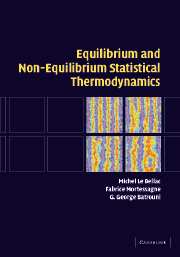Book contents
- Frontmatter
- Contents
- Preface
- 1 Thermostatics
- 2 Statistical entropy and Boltzmann distribution
- 3 Canonical and grand canonical ensembles: applications
- 4 Critical phenomena
- 5 Quantum statistics
- 6 Irreversible processes: macroscopic theory
- 7 Numerical simulations
- 8 Irreversible processes: kinetic theory
- 9 Topics in non-equilibrium statistical mechanics
- Appendix
- References
- Index
9 - Topics in non-equilibrium statistical mechanics
Published online by Cambridge University Press: 03 December 2009
- Frontmatter
- Contents
- Preface
- 1 Thermostatics
- 2 Statistical entropy and Boltzmann distribution
- 3 Canonical and grand canonical ensembles: applications
- 4 Critical phenomena
- 5 Quantum statistics
- 6 Irreversible processes: macroscopic theory
- 7 Numerical simulations
- 8 Irreversible processes: kinetic theory
- 9 Topics in non-equilibrium statistical mechanics
- Appendix
- References
- Index
Summary
We have given in two previous chapters a first introduction to non-equilibrium phenomena. The present chapter is devoted to a presentation of more general approaches, in which time dependence will be made explicit, whereas in practice we had to limit ourselves to stationary situations in Chapters 6 and 8. In the first part of the chapter, we examine the relaxation toward equilibrium of a system that has been brought out of equilibrium by an external perturbation. The main result is that, for small deviations from equilibrium, this relaxation is described by equilibrium time correlation functions, called Kubo (or relaxation) functions: this result is also known as ‘Onsager's regression law’. The Kubo functions turn out to be basic objects of non-equilibrium statistical mechanics. First they allow one to compute the dynamical susceptibilities, which describe the response of the system to an external time dependent perturbation: the dynamical susceptibilities are, within a multiplicative constant, the time derivatives of Kubo functions. A second crucial property is that transport coefficients can be expressed in terms of time integrals of Kubo functions. As we limit ourselves to small deviations from equilibrium, our theory is restricted to a linear approximation and is known as linear response theory. The classical version of linear reponse is somewhat simpler than the quantum one, and will be described first in Section 9.1. We shall turn to the quantum theory in Section 9.2, where one of our main results will be the proof of the fluctuationdissipation theorem.
- Type
- Chapter
- Information
- Equilibrium and Non-Equilibrium Statistical Thermodynamics , pp. 513 - 586Publisher: Cambridge University PressPrint publication year: 2004



